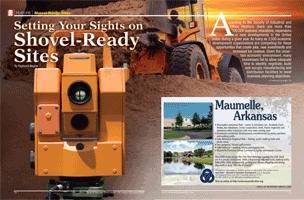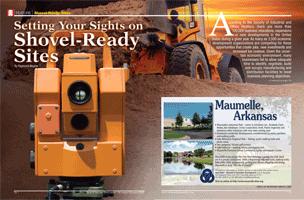
 According to the Society of Industrial and Office Realtors, there are more than 100,000 business relocations, expansions or new developments in the United States during a given year. As many as 3,500 economic development organizations are competing for these opportunities that create jobs, new investments and increased tax revenue. Given the uncertain economic environment, many businesses fail to allow adequate time to identify, negotiate, build and occupy manufacturing and distribution facilities to meet business planning objectives.
According to the Society of Industrial and Office Realtors, there are more than 100,000 business relocations, expansions or new developments in the United States during a given year. As many as 3,500 economic development organizations are competing for these opportunities that create jobs, new investments and increased tax revenue. Given the uncertain economic environment, many businesses fail to allow adequate time to identify, negotiate, build and occupy manufacturing and distribution facilities to meet business planning objectives.
States, counties and cities are addressing the concerns of potential investors by providing shovel-ready sites as an incentive to relocate. With a shovel-ready site, a client can begin construction of their facility once they sign on the dotted line. With these sites the risks associated in relocating are minimized as the entitlement process has been cleared, environmental and local zoning regulations handled and a host of other benefits. Areas offering shovel-ready sites are emerging as the top choice among real estate executives and consultants.
For companies, the existence of shovel-ready sites is becoming one of the key criteria for selecting new locations. Areas which do not offer shovel-ready sites are often eliminated at the beginning of the site selection process and are no longer considered as viable locations.
Time is of the Essence
During the past decade, the global business environment has been more turbulent than ever. Trade imbalances, political instability, changing labor markets and financial uncertainty all add up to an investment environment that is uncertain at best and highly unpredictable.
It is in this planning environment that businesses are growing, consolidating or downsizing have to make long-term capital investment decisions. Since change seems to becoming at a faster pace than ever these days, the environment for making the decision on a new plant is much more uncertain.
Furthermore, there have been very few new manufacturing buildings constructed in the last decade, so companies that do need to expand quickly to capture market share or relocate operations, lack the flexibility that an available manufacturing building offers. Often times, a new greenfield site is the only option for new facilities. Since constructing a new building on a greenfield site requires nine to 12 months of planning and construction time, shovel-ready sites become more important than ever.
Slim ‘Pickins’ Out There
Despite the fact that there are many areas of the country that would like to compete for new jobs and investment, there are few areas that have prepared for this demand by reserving large tracts of land for industrial parks, or large industry sites. Competing land uses in urban areas, such as the demand for housing, retail space and distribution sites have driven manufacturing operations to smaller exurban and rural areas where land is more available and building costs are generally less expensive. These exurban and rural areas have typically taken the lead in the creation of shovel ready sites by converting large parcels of agricultural or woodlands into developable industrial sites.
What are Shovel-Ready Sites?
Shovel-ready sites are industrial areas that have been pre-qualified as having proper land use designation, utilities, transportation improvements, availability and pricing.
Many states or areas have differing definitions of what a shovel-ready site is, but common criteria include established pricing, terms and conditions so that property acquisition can be negotiated quickly, and without haggling over price. Shovel-ready sites are typically “fully-served” with sewer, water, electricity, and natural gas in industrial quantities available either immediately nearby or on-site. If utilities are lacking, or are not currently on-site, there are specific plans in place for acquisition of right-of-way and funding of extensions.
Often times, utilities have plans in place for expansion of capacity to service the site if larger loads are required. Shovel-ready sites typically have had at least a Phase I environmental report and soils boring tests in order to determine that the site is truly development ready. If there are environmental issues associated with the site or if there are drainage or wetlands problems, these issues will have typically been dealt with prior to shovel-ready designation.
All transportation improvements to get trucks, employees, barge traffic or rail (if available) will have been planned for and the community will know whether or not specific improvements, such as a rail spur, are feasible and, if so, the cost associated with making these improvements. Ideally, specific pools of money have been identified in order to expedite these improvements, if the economic development project in question warrants it.
Why Are Shovel-Ready Sites Important?
Shovel-ready sites have become more important during the last several years due to the globally turbulent investment environment. Rising energy costs, government deficits, terrorism and war have all contributed to a very uncertain investment environment.
The development community has reacted to this uncertainty by being very selective when it comes to the development of speculative industrial and business parks. In addition, corporate boards are very circumspect when it comes to authorizing new investments in plant and equipment. The combination of these two trends results in a shortage of fully developed industrial sites coupled with reluctance on the part of corporations to commit to long term investments. As the need for new facilities increases, the pressure to move quickly on the part of corporate decision-makers mounts. This, in turn, puts pressure on communities to react quickly to the needs of businesses for new sites and facilities.
Getting Started
In a dynamic business environment, companies need to move decisively and seize opportunity when it arises. There are communities throughout the United States that understand this and stand ready to assist companies by providing shovel-ready sites. Another great way for companies to start their search for a shovel-ready site is by contacting a site selection consultant or a statewide economic development association.

